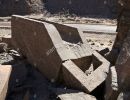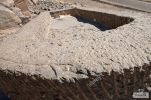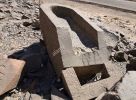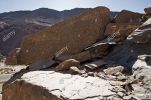It looks like you're using an Ad Blocker.
Please white-list or disable AboveTopSecret.com in your ad-blocking tool.
Thank you.
Some features of ATS will be disabled while you continue to use an ad-blocker.
share:
a reply to: Byrd
SO... back the OP
This same masonry is found in Egypt... and in other places around the world at a time when bronze was the best tools... or rocks apparently
perfectly smooth super hard rock structures... polygonal masonry... and symbolism
Not to mention all of them having "gods" which taught them technology...
Perhaps all different times in history, but what do you say to one origin... perhaps even the same people that started it all from another time before history as we know it...
perhaps even another planet... which is obviously far fetched but...
bronze doesn't do much to granite...
I'd show you a video but... you don't seem to like them...
Ok... but do you believe these people could actually make these structures with their tools...
not just carving blocks, but cutting into cliff sides... You didn't happen to notice the checkboard lines carved into that area.... you can't make marks like that with bronze chisels or rocks...
SO... back the OP
This same masonry is found in Egypt... and in other places around the world at a time when bronze was the best tools... or rocks apparently
perfectly smooth super hard rock structures... polygonal masonry... and symbolism
Not to mention all of them having "gods" which taught them technology...
Perhaps all different times in history, but what do you say to one origin... perhaps even the same people that started it all from another time before history as we know it...
perhaps even another planet... which is obviously far fetched but...
And yes, they had bronze tools and a boatload of experience cutting stone by then.
bronze doesn't do much to granite...
I'd show you a video but... you don't seem to like them...
A little more research shows that the "doorway" shrine (if that's what we're discussing) is in Ollataytambo - which was part of the estate of the emperor Pachacuti who lived from 1418–1471/1472. He ruled the kingdom of Cusco and is responsible for Machu Piccu.
Ok... but do you believe these people could actually make these structures with their tools...
not just carving blocks, but cutting into cliff sides... You didn't happen to notice the checkboard lines carved into that area.... you can't make marks like that with bronze chisels or rocks...
edit on 19-2-2022 by Akragon because: (no reason given)
a reply to: Akragon
I did find this as a possibility. Using a water wheel as the power for the shaping and cutting.
Petrie (c1977) states that Predynastic stone vessels exhibit markings consistent with grinding in a up and down direction, and it is in the Early Dynastic that the circular tool marks that suggest turning in a block begin to appear. The quality of early Predynastic stone vessels demonstrates the ability of the ancient Egyptians to produce symmetrical vessels in stone and that it existed prior to the development of a possible lathe-like tool.The ability of the ancient Egyptians to produce symmetrical shapes without a lathe is also demonstrated in their ability to carve fine statuary in a variety of complex forms. However, the only prerequisites for a lapidary lathe and other simpler devices is that the object being worked and the grinding tools be held ridged as the object is rotated. This does not have to be a high-speed or high-pressure type tool, only enough pressure to cause abrasion between the grinding surface and the object being worked is needed. The optimum pressure for lapidary cutting using quartz abrasive is < 1 kg/cm2 (Stocks 2001). Such tools may involve the adaptation of a turntable (slow-wheel), potter's wheel, or the bow-drill. The object being worked could be placed on pivots and hand-rotated, or the bow drill could be modified into a partial rotary pole-lathe. Pole-lathes are tools that rotate the object back and forth rather than spinning it. If a primitive lathe was used by the ancient Egyptians, it might be expected that in most cases it was used as a finishing tool for fine dressing the vessel's form. All the rough shaping would be done by percussion and other types of lapidary techniques, since in most cases the removal of waste rock is more efficient and less time consuming by these methods. The lack of pivot holes on stone vessels is a problem although these may have been removed during finishing of the vessel's outer surface.
I did find this as a possibility. Using a water wheel as the power for the shaping and cutting.
Petrie (c1977) states that Predynastic stone vessels exhibit markings consistent with grinding in a up and down direction, and it is in the Early Dynastic that the circular tool marks that suggest turning in a block begin to appear. The quality of early Predynastic stone vessels demonstrates the ability of the ancient Egyptians to produce symmetrical vessels in stone and that it existed prior to the development of a possible lathe-like tool.The ability of the ancient Egyptians to produce symmetrical shapes without a lathe is also demonstrated in their ability to carve fine statuary in a variety of complex forms. However, the only prerequisites for a lapidary lathe and other simpler devices is that the object being worked and the grinding tools be held ridged as the object is rotated. This does not have to be a high-speed or high-pressure type tool, only enough pressure to cause abrasion between the grinding surface and the object being worked is needed. The optimum pressure for lapidary cutting using quartz abrasive is < 1 kg/cm2 (Stocks 2001). Such tools may involve the adaptation of a turntable (slow-wheel), potter's wheel, or the bow-drill. The object being worked could be placed on pivots and hand-rotated, or the bow drill could be modified into a partial rotary pole-lathe. Pole-lathes are tools that rotate the object back and forth rather than spinning it. If a primitive lathe was used by the ancient Egyptians, it might be expected that in most cases it was used as a finishing tool for fine dressing the vessel's form. All the rough shaping would be done by percussion and other types of lapidary techniques, since in most cases the removal of waste rock is more efficient and less time consuming by these methods. The lack of pivot holes on stone vessels is a problem although these may have been removed during finishing of the vessel's outer surface.
originally posted by: Akragon
And yes, they had bronze tools and a boatload of experience cutting stone by then.
bronze doesn't do much to granite...
There's is no such thing as "black granite." There are four or five different types of stone that are sometimes referred to as black granite - primarily gabbro. Sometimes basalt.
Both carve easily enough (relatively speaking, I mean I wouldn't want to have the job,) with the bronze tools the Inca had.
Harte
a reply to: Harte
Do you have any idea why mainstream archaeology has claimed that they have found pools of liquid state mercury?
Pools so large that statues were recovered from it.
Surely they did not just go for the disney cash grab and made it all up.. Right?
Do you have any idea why mainstream archaeology has claimed that they have found pools of liquid state mercury?
Pools so large that statues were recovered from it.
Surely they did not just go for the disney cash grab and made it all up.. Right?
originally posted by: just4fun
a reply to: Akragon
I have always had a theory that the ancient gods were real people with advanced technology.
Probably after some great reset of society everyone else was plunged into the dark ages except them.
They sat up on that mountain with electricity and indoor plumbing and played god
I had some simular idea about what these gods were these diferent tribes all over the world talk about. For all we know these gods were atlantian scientists who survived the deluge and went out into the world to bring knowledge and civilliazation among the people. How did the maya, some african and so on know about star constelations and such without any previous education. Its no coincedance that these constructions with "puzzle" bricks appear all over the world.. And all seemingly at the same time in history..
The facts are so in our face that I do not understand thast the mainstream scientists do not recognize something doesnt add up in their timeline. I think that slowly but surely these convictions among the new generation of scientists are changing. The consensus is based on reputations instead of the facts. History has proven that it is dangerous for a scientists his career to go against what is accepted as fact. But that is changing...as graham hankock said...stuff is getting older.
The recently discovered younger dryas event plays an important role in this accepted change of the history of the world.
edit on 19/2/2022 by zatara because: (no reason given)
originally posted by: Akragon
a reply to: Byrd
SO... back the OP
Right-ho! Onward!
This same masonry is found in Egypt... and in other places around the world at a time when bronze was the best tools... or rocks apparently perfectly smooth super hard rock structures... polygonal masonry... and symbolism
The stonework in Egypt is usually made up of blocks. And you can polish a stone with the same type of stone... in fact, you can polish almost any stone except diamond with plain old quartz sand. They've got a boatload of that in Egypt.
(this is where (no kidding) the term "sanding" comes from -- using sand to smooth and polish.
Not to mention all of them having "gods" which taught them technology...
Be careful with this claim. Which cultures and which gods, specifically? There's no Egyptian deity that taught stonework and I can't think of a Mesoamerican deity that taught stonework.
Perhaps all different times in history, but what do you say to one origin... perhaps even the same people that started it all from another time before history as we know it...
perhaps even another planet... which is obviously far fetched but...
In that case, why didn't they teach the "new improved method" when they delivered the instructions to a new culture? For instance, by the time the Inca arose, even Egypt had iron tools and iron smelting. Why didn't they show the Inca how to forge metal tools (and where to find the relatively abundant iron deposits)? Why didn't they teach them how to make finely detailed statues with these tools (think of the lovely Greek statues) out of the local marble, jade, and so forth?
The civilization had all the basic requirements and certainly could have understood and used it. Why didn't they do that?
And why didn't they show them things like sanitation and how to build aqueducts?
bronze doesn't do much to granite...
I'd show you a video but... you don't seem to like them...
Depends on how you use it. Wood is far softer than most everything, but I assure you that trees can grow into granite and split it apart. Humans have used that method (soaking wood) to split stone for many many centuries.
So... think outside the box, here (or maybe inside the materials science box.)
A little more research shows that the "doorway" shrine (if that's what we're discussing) is in Ollataytambo - which was part of the estate of the emperor Pachacuti who lived from 1418–1471/1472. He ruled the kingdom of Cusco and is responsible for Machu Piccu.
Ok... but do you believe these people could actually make these structures with their tools...
(joke incoming) Well, they certainly didn't make them by gnawing them with their teeth! (joke ending) -- though the apatite in teeth is as hard as some of the minerals in granite. Yes, I do believe it, particularly looking at their road construction and at the ornamentation and statue construction. They worked nephrite jade, which has the same hardness as granite.
not just carving blocks, but cutting into cliff sides... You didn't happen to notice the checkboard lines carved into that area.... you can't make marks like that with bronze chisels or rocks...
(saucy joke incoming) Hon, it ain't the size of your chisel. It's how you use it.
Seriously, though, humans around the world have been doing "impossible" construction things like this for a very long time, and often recording it in pictures (because they weren't very literate) and leaving evidence of their work.
a reply to: Degradation33
That image you used is from a known video they failed at it.
Many tried that but failed. One person tried it but failed.
I believe someone went in Egypt and tried that. But not fully.
If everything is achievable with today's current technology how come no one has tried to redo it in current's era and age?
Are they afraid of failing?
That image you used is from a known video they failed at it.
To demonstrate how to cut granite in a strait line all you need is a copper saw and sand.
Many tried that but failed. One person tried it but failed.
The line will be as strait as the forged saw. Just gotta keep using the groove to expand the line.
I believe someone went in Egypt and tried that. But not fully.
Everything is achievable with date correct technology
If everything is achievable with today's current technology how come no one has tried to redo it in current's era and age?
Are they afraid of failing?
originally posted by: Akragon
a reply to: Byrd
not just carving blocks, but cutting into cliff sides... You didn't happen to notice the checkboard lines carved into that area.... you can't make marks like that with bronze chisels or rocks...
The PRE-incans had saw blades, but most of the time the blades are sold off as alleged "sun god medallions", in otherwords, when people have found Incan saw blades they think it's jewelry for a sun god.
For example, this site is selling "pre-Columbian" "pre-Incan" sun medallions. It's not a medallion, it's a saw blade. Look at it from the side.
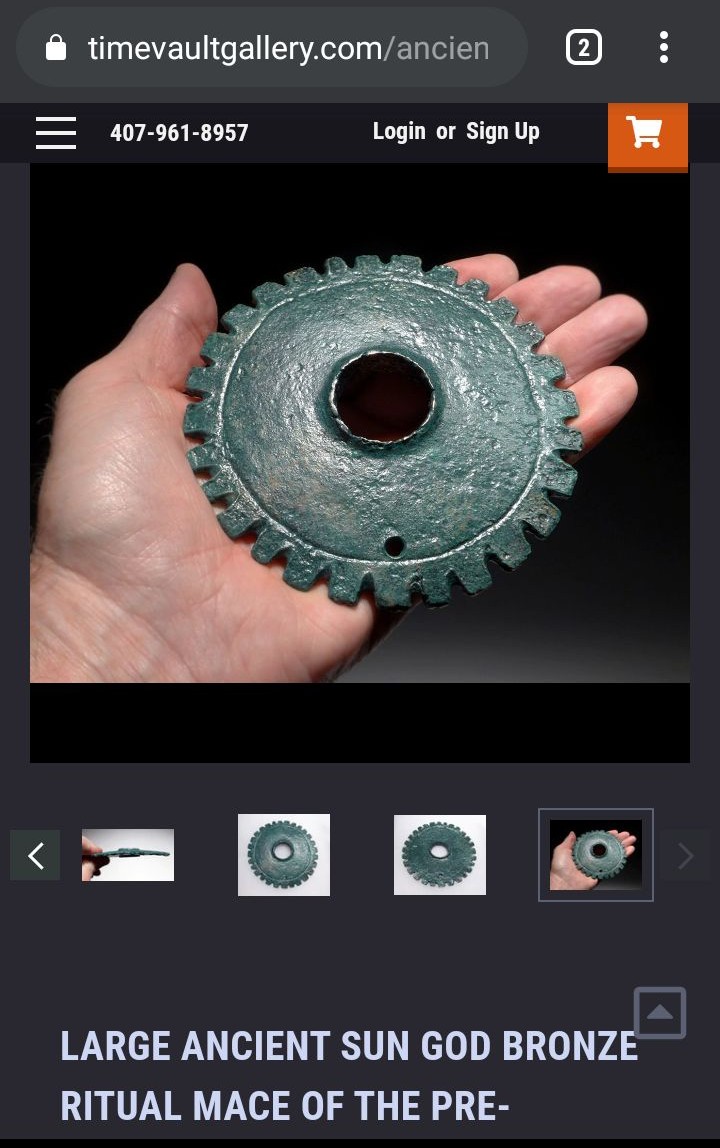
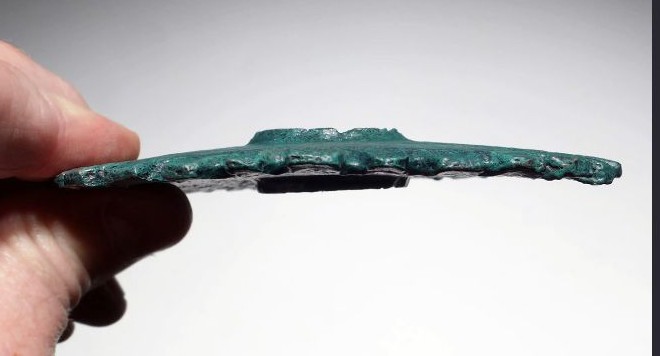
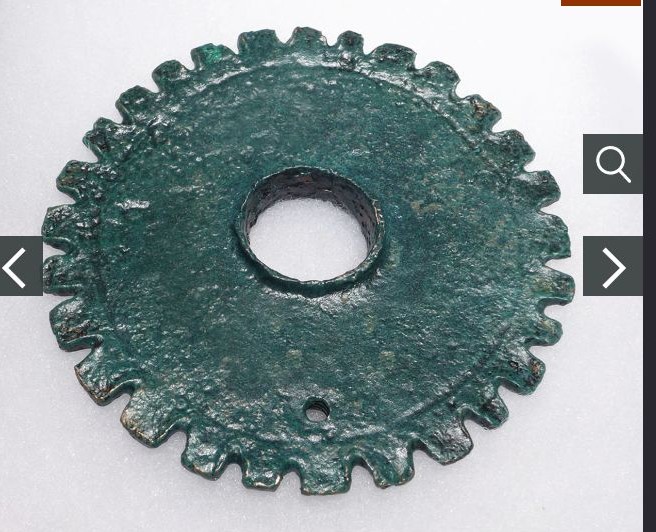
It's glossy because it was hardened with something. You never see Incan pottery with green glaze. Which makes me think that either they salted and heated the blade to form carbon nanotubes. This would make the blade harder than a diamond and it could cut thru andesite.
OR they used powdered aluminum and something else to form alumina on the blade, making the blade harder than a diamond so it could slice thru andesite.
Be careful with this claim. Which cultures and which gods, specifically? There's no Egyptian deity that taught stonework and I can't think of a Mesoamerican deity that taught stonework.
Are you familiar with Shamir, it worked on the hardest of stones and had to be stored in lead containers, it was a gift from god that was used in the construction of the temple of Solomon?
Or the Persian king Zal, and the legends of an Egyptian way of softening stone?
Or the mysterious cement mentioned by Abd el-latif?
Or have you heard about how the south american gods gave men pito and coca, it is told that pito was able to melt every stone.
I am sure there are lots of more examples.
a reply to: Akragon
The Egyptians had the materials you would need to create a hyperspace wavelength with tri-dimensional structures.
Hyperspace is mathematically defined as a space that can
hold more than one (tridimensional) volume in the same place at the same time. Electromagnetic vibrations radiate from antenna, in the form of spherical waves; spherical waves are tridimensional structures.
Empty broadcast space must be hyperspace.
A photographic hologram is a technical device that renders
the electromagnetic matrix visible in a tangible form. A
hologram is exposed by the light of a laser; a laser is a pure
frequency. If you photograph one object with a neon laser to produce a hologram in blue dye and then photograph another object on the same piece of film with an argon laser to produce another image in red dye, you will have two different stereo images occupying all of the same hologrammic plane at the same time. Now, if you shine a collimated red light through the hologram, the cyan image will be projected; a blue light will reveal the red image. The universe is a compound hologram of this kind, with each structure defined by its own wavelengths.
The Egyptians invented dyes so powerful they can still be seen today.
In a real wave,phase velocity
revolves on a plane perpendicular to the axis of wave length.The diameter of the phase helix expands on the radial axes, at right-angles to phase velocity. In this way, the three axes of hyperspace align at right-angles with each other, as all dimensions should.
Hyperspace can be understood only by minds that can perceive the scales above and below the normal
definition of reality.
The Egyptians had the materials you would need to create a hyperspace wavelength with tri-dimensional structures.
Hyperspace is mathematically defined as a space that can
hold more than one (tridimensional) volume in the same place at the same time. Electromagnetic vibrations radiate from antenna, in the form of spherical waves; spherical waves are tridimensional structures.
Empty broadcast space must be hyperspace.
A photographic hologram is a technical device that renders
the electromagnetic matrix visible in a tangible form. A
hologram is exposed by the light of a laser; a laser is a pure
frequency. If you photograph one object with a neon laser to produce a hologram in blue dye and then photograph another object on the same piece of film with an argon laser to produce another image in red dye, you will have two different stereo images occupying all of the same hologrammic plane at the same time. Now, if you shine a collimated red light through the hologram, the cyan image will be projected; a blue light will reveal the red image. The universe is a compound hologram of this kind, with each structure defined by its own wavelengths.
The Egyptians invented dyes so powerful they can still be seen today.
In a real wave,phase velocity
revolves on a plane perpendicular to the axis of wave length.The diameter of the phase helix expands on the radial axes, at right-angles to phase velocity. In this way, the three axes of hyperspace align at right-angles with each other, as all dimensions should.
Hyperspace can be understood only by minds that can perceive the scales above and below the normal
definition of reality.
originally posted by: mcsnacks77
a reply to: Akragon
The Egyptians had the materials you would need to create a hyperspace wavelength with tri-dimensional structures.
Hyperspace is mathematically defined as a space that can
hold more than one (tridimensional) volume in the same place at the same time. Electromagnetic vibrations radiate from antenna, in the form of spherical waves; spherical waves are tridimensional structures.
Empty broadcast space must be hyperspace.
A photographic hologram is a technical device that renders
the electromagnetic matrix visible in a tangible form. A
hologram is exposed by the light of a laser; a laser is a pure
frequency. If you photograph one object with a neon laser to produce a hologram in blue dye and then photograph another object on the same piece of film with an argon laser to produce another image in red dye, you will have two different stereo images occupying all of the same hologrammic plane at the same time. Now, if you shine a collimated red light through the hologram, the cyan image will be projected; a blue light will reveal the red image. The universe is a compound hologram of this kind, with each structure defined by its own wavelengths.
The Egyptians invented dyes so powerful they can still be seen today.
In a real wave,phase velocity
revolves on a plane perpendicular to the axis of wave length.The diameter of the phase helix expands on the radial axes, at right-angles to phase velocity. In this way, the three axes of hyperspace align at right-angles with each other, as all dimensions should.
Hyperspace can be understood only by minds that can perceive the scales above and below the normal
definition of reality.
My meat has trouble following the information in your post because of the limitations and quality of said meat.
But my gut is telling me you are close to the truth. Where can i read more about this?
a reply to: XipeTotex
Unexplainable.net. The dimensions of hyperspace. It’s a really good explanation about whoever was in Egypt, if it was Egyptians or an intelligence far beyond our understanding, knew how to move dimensional across time, space and existence. And around 3200 B.C. there was a disturbance planet wide that caused both the north and South Pole to freeze which would indicate a breech into hyperspace had occurred from a thermodynamic response.
Unexplainable.net. The dimensions of hyperspace. It’s a really good explanation about whoever was in Egypt, if it was Egyptians or an intelligence far beyond our understanding, knew how to move dimensional across time, space and existence. And around 3200 B.C. there was a disturbance planet wide that caused both the north and South Pole to freeze which would indicate a breech into hyperspace had occurred from a thermodynamic response.
originally posted by: MapMistress
For example, this site is selling "pre-Columbian" "pre-Incan" sun medallions. It's not a medallion, it's a saw blade. Look at it from the side.
I'm going to go with a) it's misidentified or b) it's fake.
Sun god medallions don't look like that -- at least, not the authentic ones from pre-Columbian civilizations. And although the site proclaims it's a mace, it most assuredly is not.
It's glossy because it was hardened with something. You never see Incan pottery with green glaze. Which makes me think that either they salted and heated the blade to form carbon nanotubes. This would make the blade harder than a diamond and it could cut thru andesite.
OR they used powdered aluminum and something else to form alumina on the blade, making the blade harder than a diamond so it could slice thru andesite.
Or it's fake.
I am going to leave the final judgment to Hans (who has worked with and knows MesoAmerican material) but frankly the workmanship isn't what one expects from these civilizations and the bronze looks rather like enameled copper.
I could be wrong - but at this point I'm very skeptical since I don't see any other examples of this type of artifact.
originally posted by: XipeTotex
Be careful with this claim. Which cultures and which gods, specifically? There's no Egyptian deity that taught stonework and I can't think of a Mesoamerican deity that taught stonework.
Are you familiar with Shamir, it worked on the hardest of stones and had to be stored in lead containers, it was a gift from god that was used in the construction of the temple of Solomon?
No, but now that I look it up in the Jewish Encyclopedia there's still nothing there about a deity teaching stonework (which was the discussion point) and there are multiple (and inconsistent) tales which are similar to rabbinical teaching stories but not to actual history.
And Solomon is problematic. Texts put his reign about 970–931 BCE, but he certainly wasn't commanding djinn (as the legends have it, because the other civilizations of the area would have been writing about this at this time.
Or the Persian king Zal,
Again, no...but here again this seems to be a character from legend... or possibly fiction (or very fictionalized personal histories) He would have lived around 200 BC at a time when the Persians were doing amazing stonework.
No gods seem to have descended to teach them suddenly how to do stonework that was impossible for previous generations.
and the legends of an Egyptian way of softening stone?
Okay... THIS one I can answer definitively from my own studies... and there's no such thing.
Or the mysterious cement mentioned by Abd el-latif?
Another one unknown to me, but I see he lived around the 13th century AD. I don't see any mention of cement.
Or have you heard about how the south american gods gave men pito and coca, it is told that pito was able to melt every stone.
The only references I see to this are VERY unreliable and get other details wrong (the Jews did NOT say that shamish was used by roosters) - I don't see any true ancient sources with this - and the relevant civilizations would have been there sometime after 1200 AD. Surely the Spanish would have noted and written about such a plant and technique.
Legends may have several threads of truth or even be mostly true, but they don't count as evidence.
originally posted by: surfer_soul
a reply to: Hanslune
Have you worked quartz with simple and rocks? Can you explain how it was done? The intricate quartz heads in the British Muesum for example?
How about overcuts in hard stone, don’t you think they would have noticed long before they made such deep unnecessary cuts if they were using simple tools and methods? My answer isn’t ‘magic’ and I have never claimed such. Every attempt at recreating the methods put forward with basic tools I have seen isn’t feasible.
Yes, it can be knapped into a stone tools if you use bipolar knapping, traditional 'free' knapping can be very challenging. It's hard but brittle.
phys.org...
journals.plos.org.../journal.pone.0101534
Problems with this link: Add https:// to the line below
journals.plos.org/plosone/article?id=10.1371/journal.pone.0101534
Bipolar knapping, , is a method which involves the interaction of anvils, hammerstones and the raw material exploited. However, bipolar artifacts and the functional contexts in which they are used are not well known
www.youtube.com...
Sorry, don't understand your question/comment on cuts?
You said, "Every attempt at recreating the methods put forward with basic tools I have seen isn’t feasible"
Based on what criteria? Explain please. If nothing is feasible then how are you suggesting it was cut? 'Magic''?
I think we can agree they were cut and worked, since you don't like the idea of smart people using simple tools what exactly remains?
High tech? No evidence
Fantasy methods like mental powers, softening, sound, you name it....same problem, no evidence.
edit on 20/2/22 by Hanslune because: (no reason
given)
edit on 20/2/22 by Hanslune because: (no reason given)
It would be something if there actually was a Hyborian Age civilizations prior to a widespread flood that sunk them.
I wouldn't could them advance, just could of been a bit head of the curb with most of recorded history.
I wouldn't could them advance, just could of been a bit head of the curb with most of recorded history.
edit on 21-2-2022 by Proto88 because:
(no reason given)
originally posted by: Byrd
originally posted by: MapMistress
For example, this site is selling "pre-Columbian" "pre-Incan" sun medallions. It's not a medallion, it's a saw blade. Look at it from the side.
I'm going to go with a) it's misidentified or b) it's fake.
Sun god medallions don't look like that -- at least, not the authentic ones from pre-Columbian civilizations. And although the site proclaims it's a mace, it most assuredly is not.
I know. I agree. Sun medallions were made of gold. There's no such thing as an Incan "green sun". And I really don't think neither copper nor bronze could go green like that while maintaining such a glossy shine. Which makes me think the material is something else.
Here's a link to the info on the site. The seller really seems to think it's an Incan mace. Maces don't look like that either. Saw blades do.
Incan, PreColumbian Artifact
The luster of the metal, green, makes me wonder if it's some sort of alumina (powdered aluminum compound) to make the blade stronger than diamonds. It's a weird artifact.
new topics
-
Ukraine halts transit of Russian gas to Europe after a prewar deal expired
Political Conspiracies: 19 minutes ago -
Welp...Happy New Year!!
General Chit Chat: 2 hours ago -
Vehicle Strikes people in New Orleans
Mainstream News: 3 hours ago -
The Hand that Rocks the Cradle - Labour Plans “diversities of our society” Curriculum Change
Regional Politics: 3 hours ago
top topics
-
Vehicle Strikes people in New Orleans
Mainstream News: 3 hours ago, 10 flags -
The Hand that Rocks the Cradle - Labour Plans “diversities of our society” Curriculum Change
Regional Politics: 3 hours ago, 4 flags -
SCOTUS Chief Justice JOHN ROBERTS Ends 2024 Describing His Fears for Safety of U.S. Judges.
Above Politics: 12 hours ago, 3 flags -
Welp...Happy New Year!!
General Chit Chat: 2 hours ago, 2 flags -
Ukraine halts transit of Russian gas to Europe after a prewar deal expired
Political Conspiracies: 19 minutes ago, 1 flags
active topics
-
Ukraine halts transit of Russian gas to Europe after a prewar deal expired
Political Conspiracies • 7 • : xuenchen -
The C.D.C. Says There Was NO INFLUENZA Worth Reporting for the 2020-2021 Flu Season.
Diseases and Pandemics • 75 • : network dude -
Vehicle Strikes people in New Orleans
Mainstream News • 24 • : SprocketUK -
‘Something horrible’: Somerset pit reveals bronze age cannibalism
Ancient & Lost Civilizations • 41 • : Xtrozero -
The Hand that Rocks the Cradle - Labour Plans “diversities of our society” Curriculum Change
Regional Politics • 11 • : angelchemuel -
How we've changed in 100 years
Ancient & Lost Civilizations • 15 • : TheMisguidedAngel -
Simulation theory and have we reset before like a game?
Conspiracies in Religions • 39 • : Xtrozero -
Welp...Happy New Year!!
General Chit Chat • 6 • : Flyingclaydisk -
SCOTUS Chief Justice JOHN ROBERTS Ends 2024 Describing His Fears for Safety of U.S. Judges.
Above Politics • 9 • : VictorVonDoom -
New UK Petition - Close the borders! Suspend ALL immigration for 5 years!
Regional Politics • 18 • : Freeborn

